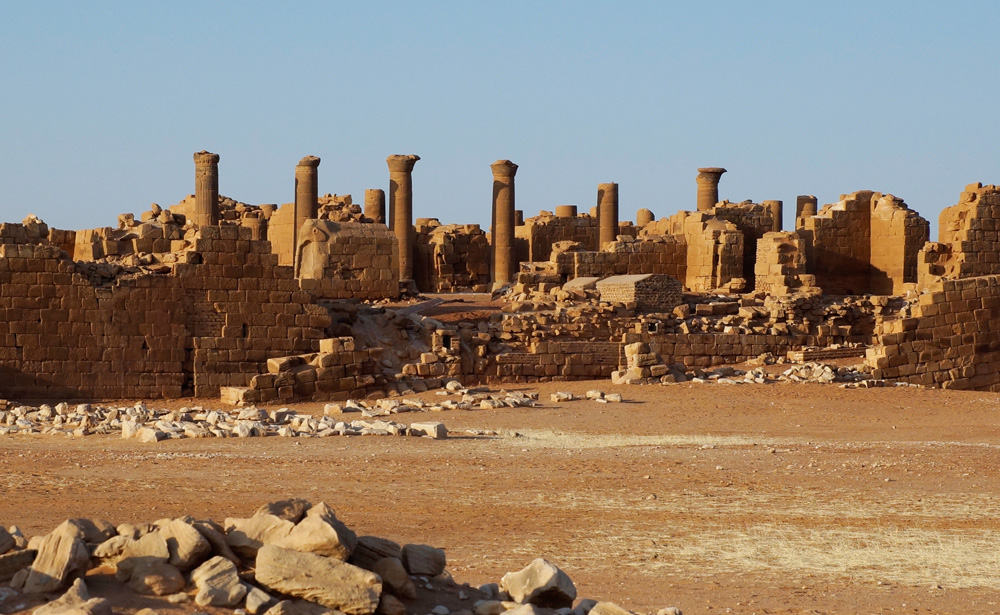Using excavation data that has already been made available, as well as data from new, intensive excavations, the research project on Musawwarat es-Sufra (Sudan) investigates innovations that were developed in connection with improving the settlement space, e.g. ensuring an adequate supply of water and building materials.
Research

Excavating in the Great Enclosure of Musawwarat es-Sufra | Copyright: Claudia Näser
The Kushite Empire (c. 750 BC to 350 AD) was the only one in a long succession of societies in the Nile valley which colonized the drylands outside the river oasis as a monumental arena of religious life. The site of Musawwarat is the most important testimony to this move. It is located 25 km away from the Nile valley in what is now the semiarid (and in antiquity was a dry savannah) landscape of the Keraba, about 180 km northeast of modern Khartoum. The site’s main monuments are an architecturally unique sacral complex (the Great Enclosure), several other temples and shrines, and two monumental water harvesting installations (the so-called hafayir). In antiquity, as now, the yearly summer rains were the only available source of water in Musawwarat.
The minor evidence for settlements and burial grounds rules out any permanent occupation at the site in Kushite times or any other period. Rather, the area was inhabited by a nomadic population – as it still is today. In relation to the Nile valley, which formed the Kushite core settlement area, the region of Musawwarat is to be defined as marginal. The project studies the trajectory, the conditions and the rationales connected to the development of Musawwarat, using the concept of ‘marginality’ as an interpretive aide.
Results
An extensive series of 14C dates drawn from selected excavation spots helped to refine the chronology of individual construction phases and episodes of use as well as the site’s overall development. Most extant buildings of the Great Enclosure originate from the Early Meroitic period, i.e. the late 4th to 2nd centuries BC. A pottery workshop in one of the enclosure’s courtyard (which forms the focus of the associated research project (A-6-5) Meroitic Fine Ceramics dates from the Middle Meroitic period, proving the ongoing use of the site in this time. Its analysis revealed a specialized production of fineware pottery on-site, most likely for use in the cult. In contrast, construction contexts of the Early Meroitic period feature pottery that was brought to the site from the Nile valley. Interestingly, also consumption pattern differ. Faunal remains from a construction context comprised 75 percent cattle and 25 percent ovicaprid bones. In contrast, the dump of the pottery workshop produced 90 percent cattle bones. This indicates both, changes in consumption ratios and a general prevalence of cattle in the diet, which suggests central provisioning and/or a high status clientele. At least, the latter ratio equals consumption patterns recorded from palatial contexts in the capital Meroe.
These and other findings defy the classification of Musawwarat as ‘marginal’ in its economic and socio-cultural dimensions. In sum, our research highlights that ‘marginality’ in one aspect does not necessarily imply ‘marginality’ in other aspects. Musawwarat was singled out for the establishment of a sacral complex which eventually grew into one of the main religious centers of the Meroitic era despite its ecologically and environmentally adverse conditions. Paradoxically, it is precisely the ‘marginality’ of Musawwarat which aids its understanding: It shows that the development of the site was not a self-propelling process. The efforts undertaken by the Kushites to establish Musawwarat as one of their main religious centers prove that this process must have been initialized and controlled by specific socio-political motivations and interests – which are mirrored both, in the technological and logistics resources mobilized for the construction and maintenance of the site, and in the detected patterns of production and consumption. The ongoing research has shown that the resources which played a role in this process were, however, not confined to material input and workforce. They also included ideational investments, such as the creation and widening of topographic knowledge, knowledge of the range and the appropriateness of specific transport techniques, and advanced skills in the site’s water management. Moreover, they comprised the generation of new forms of sacral architecture and of a new sacral topography, centering around the lion god Apedemak, whose earliest known temple was erected next to the Great Hafir at Musawwarat.
The trajectory traced at Musawwarat feeds back into methodological considerations concerning concepts of ‘marginality’. It shows that we must not limit our analytical frame of reference to scenarios in which ‘marginality’ is connected to inferiority or disadvantage. Rather, it can also be a qualifying factor and an arena of socio-cultural discourses that are central to a social group or even a whole society.
Besides several publications (www.topoi.org/person/naeser-claudia/publications/) results of the project have been presented at major international conferences e.g.
12th International Conference for Meroitic Studies, National Museum Náprstek – Museum of Asian, African and American Cultures, Prag, September 2016 | “Hugging the wall. New insights into the building history and the uselife of the Great Enclosure at Musawwarat” and together with Manja Wetendorf “Piecing together the pots and the potter’s workshop. The Musawwarat Pottery Project”
13th International Conference of Nubian Studies, Université de Neuchâtel, September 2015 | “Excavating the lion’s den. Recent fieldwork in Musawwarat es-Sufra.”
12th International Conference of Nubian Studies, British Museum, London, September 2010 | “Early Musawwarat”
